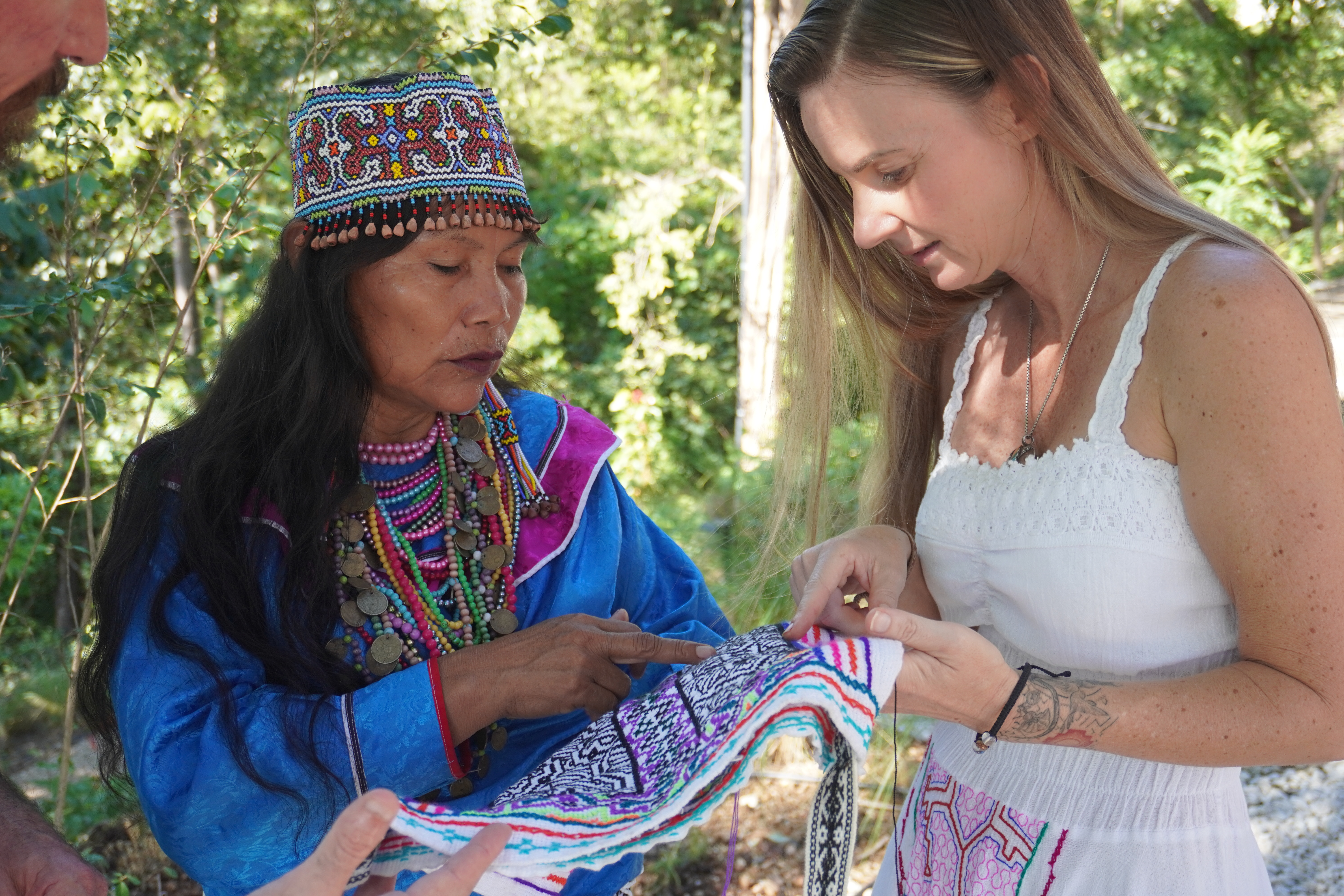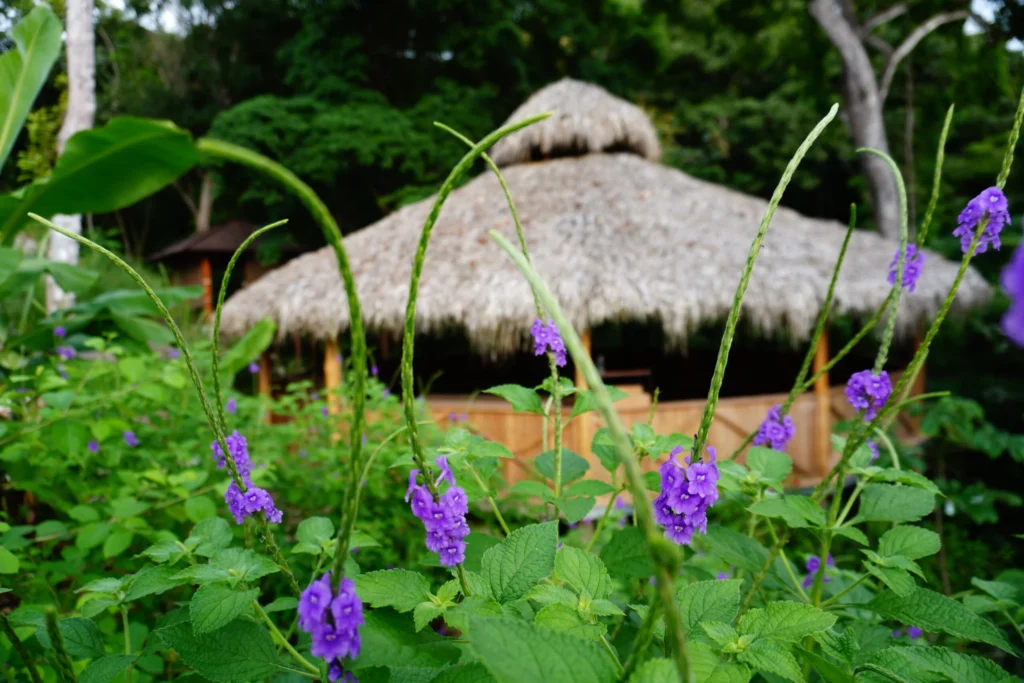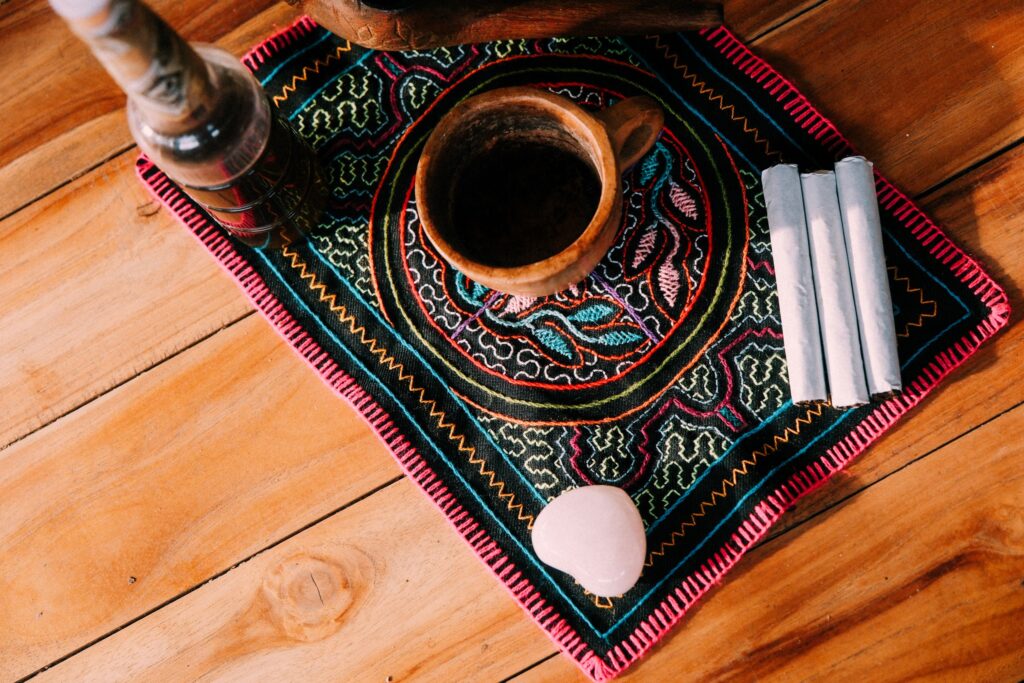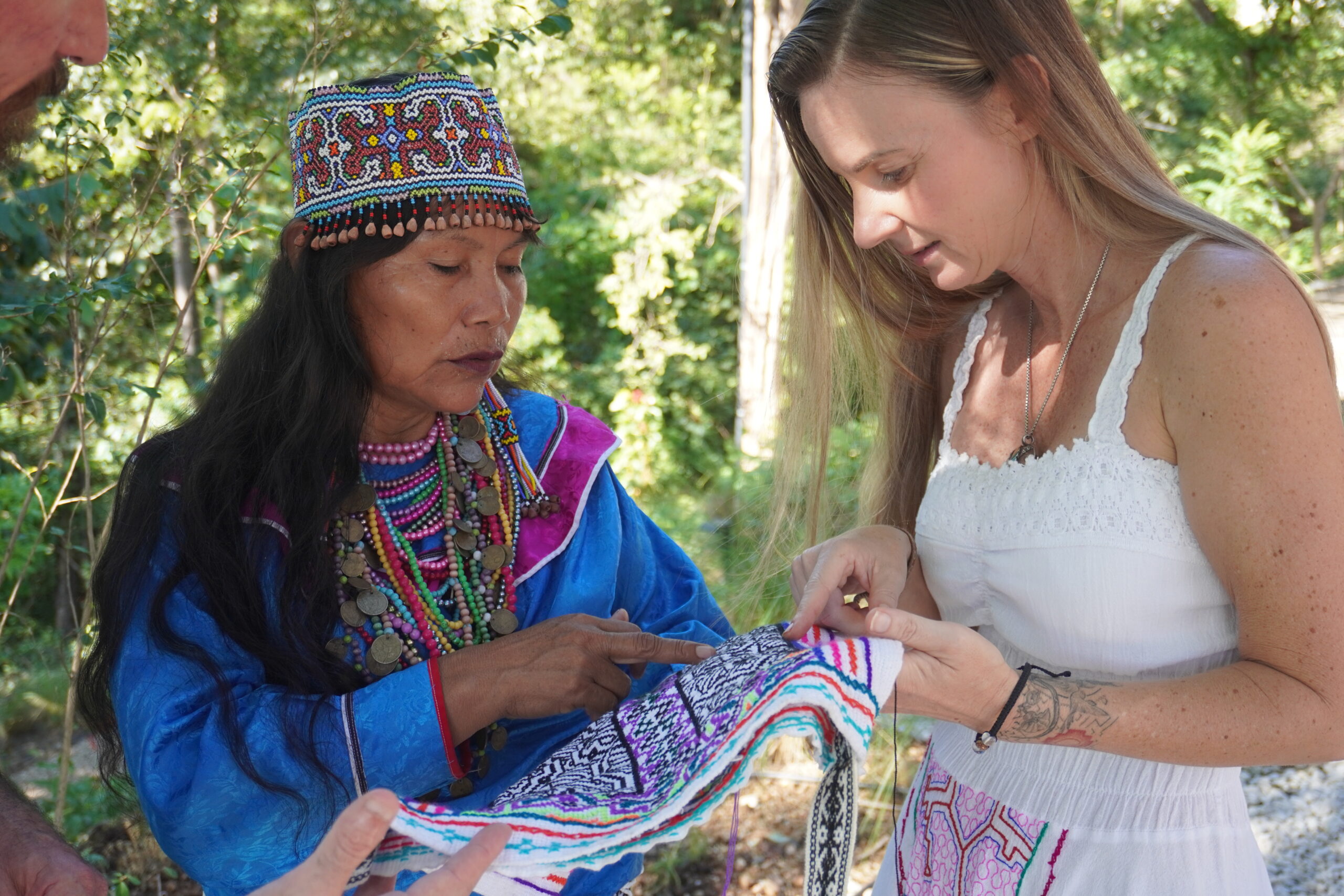Discover ancient Shipibo traditions & practices before your ayahuasca retreat. Learn more about their sacred culture, ceremonies and healing wisdom.
 Understanding the Sacred Lineage That Will Guide Your Healing Journey
Understanding the Sacred Lineage That Will Guide Your Healing Journey
Have you ever wondered about the ancient wisdom that guides Ayahuasca ceremonies? The Shipibo people of the Peruvian Amazon have preserved one of the world’s most profound plant medicine traditions for over 3,000 years, offering a doorway to healing that extends far beyond the ceremony itself.
At Ananda Lodge, we honor this sacred lineage by working with experienced Shipibo healers who bring generations of wisdom to our retreat center in Costa Rica. Understanding their rich cultural heritage will deepen your appreciation for the medicine and enhance your healing journey.
“Words cannot express how incredible and unique this place is. I have sat with Ayahuasca before but nothing compares to sitting with the Shipibo lineage.”
– Scott, Past Ayahuasca Immersion Guest
We’ll explore the fascinating world of Shipibo cosmology, their sacred art and icaros, traditional healing practices, and how to respectfully prepare for ceremonies within this lineage. Whether you’re a first-time participant or returning to deepen your practice, this knowledge will enrich your understanding and support your transformation.
Curious to learn more? Download our Free Ayahuasca Guide
The Shipibo People: Guardians of Ancient Wisdom
Origins and Cultural Heritage
The Shipibo-Conibo people, known collectively as the Shipibo, are indigenous to the Ucayali River region of Peru’s Amazon rainforest. For thousands of years, they have maintained an unbroken chain of plant medicine knowledge, passed down through generations of master healers called curanderos and curanderas.
Unlike many indigenous traditions that were disrupted by colonization, the Shipibo managed to preserve their core spiritual practices. Their remote location in the Amazon provided natural protection, allowing their shamanic traditions to flourish even as the outside world changed dramatically around them.
The Shipibo worldview centers on the concept of ayni – reciprocity and balance with all living beings. This philosophy extends to their relationship with plant medicines, which they view not as substances to be consumed, but as teacher spirits deserving of respect and reverence.
Master healers undergo decades of training, including extended periods of isolation in the jungle, strict dietary practices called dietas, and intensive work with various plant teachers. Their knowledge encompasses not only ayahuasca but hundreds of other medicinal plants and their specific applications.

Sacred Geometry: The Visual Language of the Shipibo
Understanding Shipibo Patterns and Designs
Perhaps the most recognizable aspect of Shipibo culture is their intricate geometric art, known as kené. These complex patterns appear on textiles, ceramics, and traditional clothing, but they represent far more than decorative art. Each design is a visual representation of the spiritual energies and healing songs (icaros) that flow through their ceremonies.
The patterns are said to be received directly from the plant spirits during ayahuasca visions. Master artists translate these spiritual downloads into physical form through embroidery, painting, and pottery. The geometric precision of these designs reflects the mathematical harmony that underlies the natural world.
Icaros: The Healing Songs That Guide Your Journey
The Power of Sacred Sound
Central to every Shipibo ceremony are the icaros – sacred healing songs that serve as the primary vehicle for the medicine’s effects. These aren’t simply musical accompaniments; they are considered living entities that direct the ayahuasca’s healing energy toward specific intentions and outcomes.
Each icaro is believed to have its own spirit and intelligence. Master healers spend years learning these songs, often receiving them directly from plant teachers during their own ceremonial work. The melodies, rhythms, and lyrics are precisely calibrated to work with the medicine’s effects and guide participants through their healing journey.
“Her icaros are so powerful! You will be surpised when you hear the sound that comes from this sweet little person.” – Scott, Reflecting on Maestra Olinda’s powerful Icaros from his time at Ananda Lodge
Feeling called to the medicine? Book a Free Sacred Journey Consultation with us

Traditional Healing Practices
The Sacred Dieta: Preparing Body and Spirit
Before participating in ayahuasca ceremonies, traditional Shipibo practice involves following a dieta – a comprehensive preparation that goes far beyond dietary restrictions. This sacred protocol is designed to purify the body, clarify the mind, and open the spirit to receive the medicine’s teachings.
The traditional dieta includes:
- Dietary Guidelines: Avoiding salt, sugar, spices, red meat, dairy, and processed foods to cleanse the physical body
- Sexual Abstinence: Conserving vital energy for the ceremonial work
- Energetic Cleansing: Limiting exposure to negative influences, violent media, and stressful situations
- Intention Setting: Spending time in meditation and reflection to clarify healing goals
- Plant Preparation: Sometimes working with specific plant teachers before the ayahuasca ceremony
While modern retreat centers may adapt these protocols for Western participants, understanding the traditional framework helps you approach your preparation with proper respect and intention.
Vomitivo: The Purging Ceremony
Before your first ayahuasca ceremony, you may participate in a vomitivo – a traditional purging ritual designed to cleanse the body and prepare you to receive the medicine. This ceremony typically involves drinking a concentrated herbal preparation that induces vomiting, allowing you to release physical and energetic toxins.
The vomitivo serves several important purposes:
- Physical Cleansing: Removes accumulated toxins and prepares the digestive system for the ayahuasca
- Energetic Purification: Releases negative energies and emotional blockages that might interfere with healing
- Mental Preparation: Demonstrates your commitment to the healing process and builds trust with the medicine
- Spiritual Opening: Creates space for the plant spirits to work more effectively during ceremony
While the purging experience can be challenging, participants often report feeling significantly clearer and more receptive to the ayahuasca’s teachings afterward. The curandero will guide you through this process with care and support.
Floral Baths: Energetic Cleansing and Protection
Floral baths, known as baños de flores, are an essential component of Shipibo healing practices. These ceremonial baths combine specific jungle flowers, herbs, and plants to cleanse your energetic field and provide spiritual protection before and after ayahuasca ceremonies.
The preparation and application of these baths follows specific rituals. The curandero or an assistant will often blow mapacho smoke and sing icaros over the herbal mixture, infusing it with healing intentions. As you pour the blessed water over your body, you’re asked to set clear intentions for what you wish to release and what you seek to invite into your life.
Sacred Tools and Elements in Ceremony
Understanding the various tools and elements used in traditional Shipibo ceremonies helps newcomers feel more prepared and respectful. Each item serves a specific purpose in creating and maintaining the sacred container for healing.
Icaros: The Healing Songs
As discussed earlier, icaros are the primary healing tool in Shipibo ceremonies. These sacred songs serve as:
- Energetic Medicine: Each icaro carries specific healing frequencies and intentions
- Spiritual Communication: The curandero uses songs to communicate with plant spirits and guide the ceremony
- Protective Barriers: Certain icaros create spiritual boundaries and protection around the ceremonial space
- Healing Directions: Different songs direct the medicine’s energy toward specific areas of healing needed by participants
The power of icaros extends beyond their audible presence. Many participants report seeing the songs as geometric patterns or feeling them as energy moving through their bodies during ceremony.
Mapacho: Sacred Tobacco
Mapacho (Nicotiana rustica) is a powerful sacred plant that plays a crucial role in Shipibo ceremonies. Unlike commercial tobacco, mapacho is grown and prepared specifically for spiritual purposes and contains much higher levels of nicotine and other alkaloids.
The curandero uses mapacho in several ways:
- Purification: Blowing mapacho smoke over participants, the ceremonial space, and the ayahuasca to cleanse and protect
- Spiritual Communication: The smoke carries prayers and intentions to the spirit world
- Energy Direction: Directing the healing energy and medicine effects through focused smoke application
- Grounding: Helping participants stay connected to their physical bodies during intense spiritual experiences
- Offering: Presenting mapacho to plant spirits as a gift of respect and reciprocity
Participants may also be offered mapacho to smoke during ceremony, though this is always optional and depends on individual sensitivity and the curandero’s guidance.
Agua Florida: Spiritual Cologne
Agua Florida is a traditional floral water that serves multiple purposes in Shipibo ceremonies. This fragrant preparation, made from various flowers and herbs, is used for:
- Energetic Cleansing: Spraying or sprinkling agua florida over participants to clear negative energies
- Spiritual Protection: Creating a protective barrier around the ceremonial space
- Blessing Objects: Consecrating ritual items and the ayahuasca itself
- Healing Applications: Applying to specific areas of the body that need energetic attention
- Aromatic Anchoring: Providing a pleasant, familiar scent that helps participants feel grounded and safe
The curandero may spray agua florida over you at various points during ceremony, particularly when you’re experiencing challenging moments or need additional support.
Preparing for Your Shipibo-Lineage Retreat
Setting Intentions with Cultural Sensitivity
As you prepare for your ayahuasca retreat, consider how you can honor the Shipibo tradition while remaining authentic to your own healing journey. This involves:
- Researching Respectfully: Learn about the culture without appropriating or oversimplifying their practices
- Setting Clear Intentions: Approach the medicine with specific healing goals while remaining open to unexpected teachings
- Practicing Gratitude: Acknowledge the generosity of indigenous peoples in sharing their sacred knowledge
- Committing to Integration: Honor the teachings you receive by implementing them in your daily life
Questions to Reflect On Before Your Retreat
Take time to contemplate these questions as you prepare for your ceremonial experience:
- What specific healing am I seeking through this medicine?
- How can I approach this tradition with respect and humility?
- How will I integrate these teachings into my daily life?
- What gifts can I offer back to the community and tradition?
Explore all of our Upcoming Immersions
Supporting Indigenous Communities and Traditions
Ethical Considerations in Plant Medicine Tourism
As interest in ayahuasca grows worldwide, it’s crucial to consider the impact on indigenous communities and their traditional practices. Responsible participation in plant medicine ceremonies involves:
- Supporting Indigenous Practitioners: Choosing retreat centers that work directly with traditional healers and compensate them fairly
- Respecting Cultural Boundaries: Understanding that not all aspects of indigenous traditions are meant to be shared with outsiders
- Avoiding Cultural Appropriation: Appreciating the tradition without claiming it as your own or misrepresenting its practices
- Contributing to Community Welfare: Supporting initiatives that benefit indigenous communities and protect their rights
Ways to Give Back
Consider how you can support the communities that have preserved these healing traditions:
- Donate to organizations protecting indigenous rights and territories
- Support fair trade practices when purchasing traditional crafts or art
- Advocate for the preservation of Amazon rainforest and indigenous lands
- Share your positive experiences responsibly to promote ethical plant medicine tourism
Some Resources:
Donate to Alianza Arkana
Amazon Watch | Protecting the rainforest and our climate in solidarity with Indigenous peoples
Chaikuni Institute | Protecting the Amazon
IRI | Chacruna Institute
ICEERS | Ethnobotanical Education, Research, and Service
Your Journey with Shipibo Wisdom Awaits
Understanding Shipibo traditions and practices provides a foundation of respect and appreciation for the profound healing work you’re about to undertake.
As you prepare for your ayahuasca retreat, remember that you’re not just participating in a healing ceremony; you’re entering into a sacred relationship with plant teachers and indigenous wisdom keepers who have maintained these traditions for countless generations.
The depth of Shipibo knowledge extends far beyond what can be covered in a single article. Each ceremony offers opportunities to learn directly from the plant spirits and traditional healers who carry this wisdom forward. Approach your experience with an open heart and respectful mind.
Are you ready to experience the profound healing wisdom of the Shipibo lineage?
Our upcoming retreats in Costa Rica offer intimate, authentic, trauma-informed experiences guided by traditional practitioners who bring generations of plant medicine knowledge to support your transformation.
Your Next Steps:
1. Begin your journey by Booking a Free Sacred Journey Consultation
2. Explore our Upcoming Immersions
3. Download our Free Ayahuasca Guide
4. Subscribe to our Newsletter and stay up to date with Ananda Lodge
Related Blogs:
- Plant Medicine Integration Tips for After your Retreat
- Is Ayahuasca Right For You? Here’s What To Consider
- Benefits of Ayahuasca

